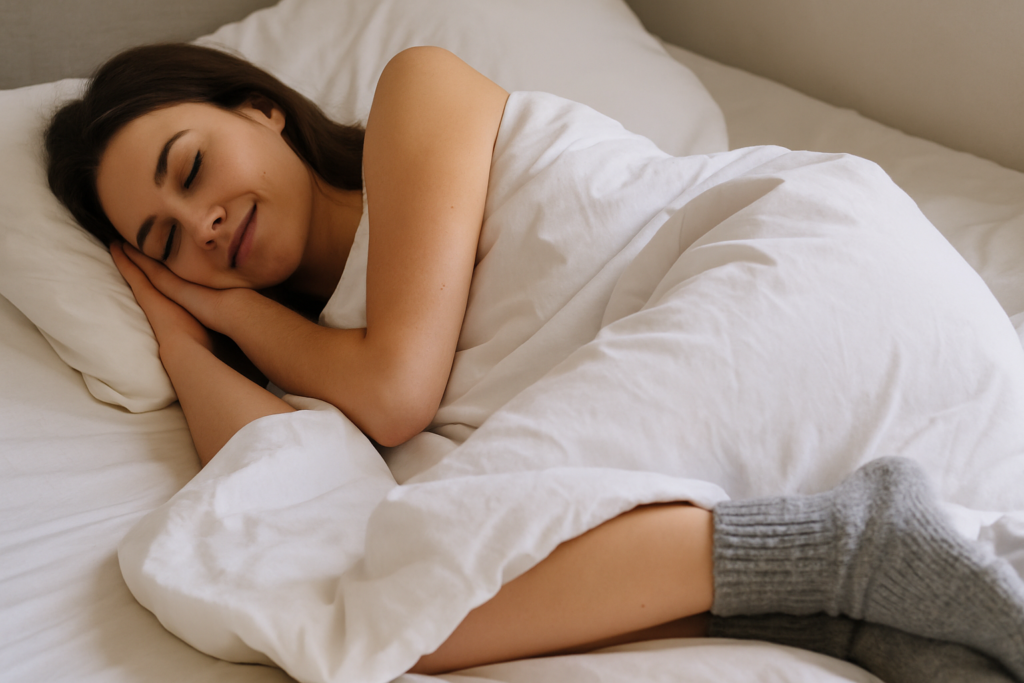If you’re one of the many people who can’t drift off until your feet are wrapped in soft cotton or wool, you probably already know the practical benefits: socks speed up sleep onset, lengthen total sleep time and cut down on those 2 a.m. awakenings by gently warming the extremities and nudging your core temperature downward.
A controlled trial from the Journal of Physiological Anthropology found that young adults wearing socks fell asleep 7.5 minutes faster and slept 32 minutes longer than when they went barefoot.
Korean researchers have replicated the effect, showing that bed‑socks shorten sleep‑onset latency, extend REM and reduce nocturnal awakenings.
Yet this simple habit does more than optimise thermoregulation; it quietly signals a constellation of personality tendencies that psychologists have been mapping for decades.
Drawing on peer‑reviewed studies of sleep, personality and sensory psychology, I’ll walk you through nine traits that tend to show up—disproportionately—among habitual sock‑sleepers.
Remember, correlation isn’t destiny: not everyone who wears socks to bed will show all of these traits. But if several resonate, you may recognise a portrait of yourself tucked beneath the covers.
1. Conscientious planners
People who place clean socks at their bedside before lights‑out are usually the same individuals who prep lunch boxes the night before and keep calendars colour‑coded. Conscientiousness—one of the Big Five traits—has been linked repeatedly to better sleep quality.
Because socks demonstrably improve sleep efficiency, it stands to reason that conscientious sleepers embrace the tactic as part of a broader “plan‑ahead” mindset. They dislike leaving things to chance, even something as minor as cold toes.
2. Pragmatic solution‑seekers
Sock‑sleepers are rarely indulgent mystics; they are practical troubleshooters. Faced with the friction of a chilly room, they pick the low‑tech fix that works.
Psychologists call this problem‑focused coping—deploying concrete actions (like putting on socks) to remove a stressor rather than simply venting about it.
The foot‑warming studies noted above reveal that socks alter peripheral skin temperature without affecting core temperature, a precise thermal tweak rather than a blanket overhaul.
That precision hints at a mind that favours simple, targeted manoeuvres over grand gestures.
3. Highly attuned to body signals (interoceptive awareness)
Interoception—the ability to perceive subtle internal cues such as heartbeat, satiety or rising chill—is intimately tied to sleep regulation.
Sleepers who notice that a mere two‑degree drop in toe temperature makes them restless are demonstrating sharp interoceptive sensitivity.
Emerging research shows that people with stronger interoceptive skills adjust their routines (from hydration to breathing patterns) more effectively to maintain homeostasis, placing sock‑wearers in a subgroup of bodily “super‑listeners.”
4. Proactive anxiety‑tamers
Thermal comfort and anxiety are locked in a feedback loop: cooler extremities elevate physiological arousal; anxiety amplifies the sensation of cold.
Workplace studies on shift‑nurses show that improving thermal comfort reduces state anxiety and eye fatigue.
Many habitual sock‑sleepers report that the instant foot‑warmth dampens the racing‑mind feeling that can precede insomnia.
Their behaviour reflects anxiety‑management foresight: they neutralise a somatic trigger before cognitive worry takes hold.
5. Disciplined about bedtime—low “bedtime procrastination”
Chronic postponement of bedtime is linked to low conscientiousness and higher impulsivity.
In contrast, sliding on socks is often part of a tight pre‑sleep ritual: herbal tea, dim lights, journal, socks, sleep.
This sequence reinforces temporal discipline; it signals to the brain that “the day is done.”
Sock‑sleepers therefore tend to score lower on bedtime procrastination scales and higher on self‑regulation metrics.
6. Evidence‑driven health enthusiasts
The surge of mainstream articles—like the Wall Street Journal’s widely shared “Sock‑Sleepers Are Not Psychopaths” piece—distilled academic findings for a lay audience.
People who adopt the practice after reading such research exhibit health literacy and openness to empirically backed micro‑behaviours (think: blue‑light filters, standing desks).
They are early adopters of small‑but‑mighty hacks validated by science rather than Instagram folklore.
7. Emotionally self‑regulating (combating neuroticism)
A large 2025 study of 595 adults found that 61.7 % of chronic insomniacs scored high on neuroticism, the personality dimension characterised by worry and emotional volatility.
Because warmer feet help people fall asleep faster, sock‑wearers give themselves a head‑start in the nightly battle against rumination and midnight awakenings.
Their choice reflects an intention to guard emotional equilibrium through better sleep hygiene—essentially a built‑in mood‑stabiliser.
8. Interpersonally warm and empathic
Classic embodied‑cognition experiments show that holding a hot cup fosters perceptions of social warmth and generosity.
Although replication debates continue, a meta‑analytic trend still finds a modest link between experiencing physical warmth and feeling (or acting) more prosocial.
Regularly cocooning one’s feet may nudge the nervous system toward the same affiliative state, meaning habitual sock‑sleepers can come across as mild‑mannered, approachable and quick to extend psychological warmth to others.
9. Sensory‑sensitive comfort optimisers
Finally, many sock‑sleepers meet the clinical threshold for sensory sensitivity: they are quick to notice an itchy label, a flickering light or (crucially) a draft at the foot of the bed.
Research in both children and adults shows that heightened sensory sensitivity amplifies sleep disturbances and, conversely, that mitigating sensory irritants (weighted blankets, blackout curtains or yes—socks) improves sleep quality.
Far from being fussy, these individuals simply possess a finely tuned sensory gain: when the world gets too loud, they’re first to engineer a quieter channel.
Putting the traits together
These nine features weave a composite sketch: a pragmatic, conscientious, bodily attuned person who values comfort, emotional equilibrium and evidence‑based self‑care—sprinkled with a dash of interpersonal warmth.
If that sounds like you, your sock drawer may be doing more than guarding against blisters; it’s a window into the priorities that shape your waking life.
A note of caution
Personality science deals in probabilities, not absolutes. Plenty of disciplined high‑achievers snooze barefoot, and some anxious night‑owls swear by wool socks but still toss and turn. What matters is using the research to run n = 1 experiments on yourself.
If slipping on socks saves you fifteen minutes of staring at the ceiling, that’s nearly two extra hours of sleep each week—time your immune system, memory‑consolidation machinery and mood‑regulation circuits will eagerly claim.
Practical take‑away
- Choose breathable fibres. Cotton or bamboo minimise sweat buildup while maintaining warmth.
- Keep them clean. Fresh socks every night prevent bacterial overgrowth.
- Pair with a cool room. Ideal bedroom temperatures sit around 18 °C (65 °F); warm feet accelerate the natural core‑body‑temperature drop that signals sleep.
- Make it ritualistic. Let the act of putting on socks serve as the final cue in your wind‑down routine.
Far from being quirky, sleeping in socks is a micro‑habit that reflects deeper psychological wiring—one that marries foresight, sensory intelligence and emotional self‑care. So the next time someone teases you for bundling up your feet, feel free to smile knowingly: science is literally at your soles.















